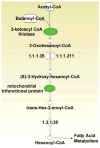In vivo space radiation-induced non-targeted responses: late effects on molecular signaling in mitochondria
- PMID: 21166651
- PMCID: PMC3330755
- DOI: 10.2174/1874467211104020106
In vivo space radiation-induced non-targeted responses: late effects on molecular signaling in mitochondria
Abstract
The lack of clear knowledge about space radiation-induced biological effects has been singled out as the most important factor limiting the prediction of radiation risk associated with human space exploration. The expression of space radiation-induced non-targeted effects is thought to impact our understanding of the health risks associated with exposure to low fluences of particulate radiation encountered by astronauts during prolonged space travel. Following a brief review of radiation-induced bystander effects and the growing literature for the involvement of oxidative metabolism in their expression, we show novel data on the induction of in vivo non-targeted effects following exposure to 1100 MeV/nucleon titanium ions. Analyses of proteins by two-dimensional gel electrophoresis in non-targeted liver of cranially-irradiated Sprague Dawley rats revealed that the levels of key proteins involved in mitochondrial fatty acid metabolism are decreased. In contrast, those of proteins involved in various cellular defense mechanisms, including antioxidation, were increased. These data contribute to our understanding of the mechanisms underlying the biological responses to space radiation, and support the involvement of mitochondrial processes in the expression of radiation induced non-targeted effects. Significantly, they reveal the cross-talk between propagated stressful effects and induced adaptive responses. Together, with the accumulating data in the field, our results may help reduce the uncertainty in the assessment of the health risks to astronauts. They further demonstrate that 'network analyses' is an effective tool towards characterizing the signaling pathways that mediate the long-term biological effects of space radiation.
Figures



References
-
- Zirkle RE, Bloom W. Irradiation of parts of individual cells. Science. 1953;117:487–493. - PubMed
-
- Hamada N, Maeda M, Otsuka K, Tomita M. Signaling pathways underpinning the manifestations of ionizing radiation-induced bystander effects. Curr Mol Pharmacol. 2011;4 in this issue. - PubMed
-
- Matsumoto H, Tomita M, Otsuka K, Hatashita M, Hamada N. Nitric oxide is a key molecule serving as a bridge between radiation-induced bystander and adaptive responses. Curr Mol Pharmacol. 2011;4 in this issue. - PubMed
-
- Morgan WF. Communicating non-targeted effects of radiation to achieve adaptive homeostasis in tissues. Curr Mol Pharmacol. 2011;4 in this issue. - PubMed
Publication types
MeSH terms
Substances
Grants and funding
LinkOut - more resources
Full Text Sources

